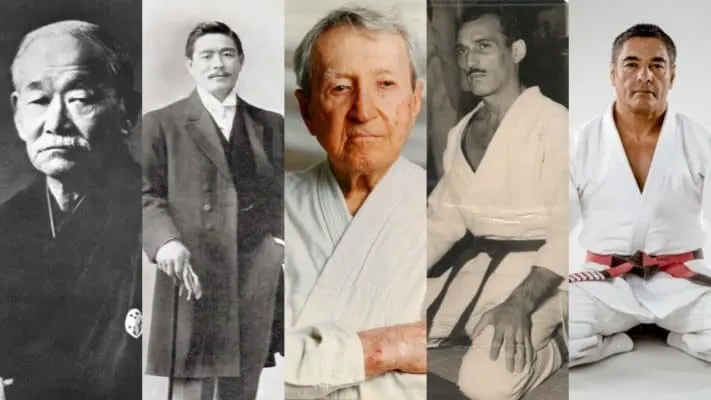
People often think that all Brazilian jiu-jitsu(BJJ) black belts are the same, particularly as a beginner to BJJ. To a white belt student, anyone who teaches grappling techniques confidently and owns a dojo can be viewed as a certified black belt. For this reason, new BJJ students may assume that there’s no need to verify their instructors’ belt linage. However, this article will discuss why it is important to verify black belt lineage so that you don’t become the next victim of poor technique.
Verifying a BJJ black belt’s lineage will ensure you receive quality training from a certified BJJ black belt instructor. Training under a fraudulent instructor will teach you poor and incomplete techniques. This will not adequately prepare you for self-defense or competitions, wasting your time and money.
I will explain this in more detail with examples below. I will also provide you with ways to check a black belt’s lineage so that you don’t get caught by the same trap.
What is BJJ Lineage?
BJJ lineage refers to who awarded your BJJ belt and also shows how that belt can be traced back to the Gracie family, the founders of Brazilian Jiu-Jitsu. Lineage is a traditional concept in martial arts that illustrates loyalty to your teacher. In BJJ, it is a way to ensure that a person’s black belt is authentic.
Tracing someone’s lineage may seem confusing if they have had multiple instructors along their BJJ journey. However, lineage always refers to the instructor who awarded you your black belt. In the case of Gordon Ryan who is a very talented American submission grappler, both John Danaher and Garry Tonon are his instructors, but it was Tonon that awarded him his black belt.
Garry Tonon trained under Tom DeBlass, who trained under Ricardo Almeida. Almeida was Renzo Gracie’s very first black belt student. That being said, if Gordon Ryan was awarded his black belt by John Danaher, his belt would still hold authenticity because Danaher trained directly under Renzo Gracie.
Why it’s Important to Verify BJJ Black Belt
When you take a lesson from a black belt, you should be confident that you are receiving instruction from a knowledgeable qualified black belt. Unfortunately, this is not always the case. There are some people who will use the title of black belt without earning it simply to entice students to their dojo.
One example of this was the case of Jay Queiroz, a supposed black belt teaching out of a small dojo in the US. Queiroz released some basic instructional videos on his website, which caught the attention of black belt Mike Palladino.
Palladino noticed the poor technique and decided to confront Queiroz. This led to the discovery that Jay Queiroz never officially made it past his white belt. He had used several relocations to cover up the fact that he simply purchased his belts online, including his black belt.
Simple mistakes that were noted in Palladino’s exposure of Queiroz include single-leg takedowns on the wrong side and lack of control during an arm-bar. Queiroz also refused to roll with Palladino and would not give a straight answer when asked who gave him his black belt.
In comparison, Palladino is a black belt under Rafael Barbosa, whose lineage traces back to Carlson Gracie through Crézio de Souza and André Almeida. Not only has Palladino’s lineage provided him with the training to become a two-time Pan American BJJ medallist, but it also gave him the ability to identify poor technique in a fraudulent dojo.
This poor technique was being passed on to Queiroz’s students, which could then be passed on to other students if they chose to teach as well. Fraudulent dojos such as this, often referred to as ‘McDojos’, waste people’s money and stain the BJJ art by breeding poor technique. Here are some tips to help you spot a bad martial art school.
Why BJJ Lineage is Important
The example above demonstrates the importance of BJJ lineage. Not only does it ensure students are dedicating their time and money to proper and effective techniques, but it also means that the art of BJJ will not be degraded over time by incorrect teachings.
A genuine black belt is considered a ‘Professor’ of the art and is deemed to have enough knowledge and skill to recognize and promote students when they are ready. Authentic lineage ensures the quality of these BJJ professors. Someone who has not gained an authentic black belt is likely to make inexperienced judgments.
When you look at world-class BJJ champions, you will see that they have received their black belt from world-class BJJ masters. For example, BJJ champion Marcus Almeida trained under Rodrigo Cavaca, who trained under Élcio Figueiredo, one of Carlson Gracie’s black belts.
Carlson Gracie was a ninth-degree black belt, earning him the title of ‘Master’ in the world of BJJ. The lineage that can be traced back to the Gracie family proves a black belt’s authenticity.
This is not to say black belts who have trained under a lesser-known master are not qualified to teach. Julio Cesar Pereira who is a highly regarded BJJ instructor, for example, has lineage that traces back to Luis França. Not many people know about França because he does not come from the lineage of the Gracie family.
However, Luis França was actually another of Mitsuyo Maeda’s pupils when Carlos Gracie was trained in Brazil. He learned all the same grappling techniques that Maeda taught Carlos Gracie, and therefore also went on to teach what became known as Brazilian Jiu-Jitsu to others.
Although Julio Cesar Pereira’s lineage does not trace back to the Gracie family, he has still learned the same techniques through the França lineage and is now a seventh-degree black belt himself. He is also an amazing coach, with his students winning 35 podium spots in the 2016 Jiu-Jitsu World Championship.
In saying that it is important to trace a black belt’s lineage to ensure it is reputable. This guarantees that quality BJJ techniques are being passed down through the generations.
Is Black Belt the Highest in Jiu Jitsu?
Black belts are the highest belts in BJJ. However, there are 10 degrees within the black belt system. Once you reach the seventh and eighth degree as a black belt, you are awarded a coral belt. If you continue on to your ninth or tenth degree as a black belt, you are awarded a red belt.
However, a coral or red belt is still classified as a black belt. These belts are still denoted as ‘seventh degree black belt’ or ‘eighth degree black belt’ for a coral belt, and ‘ninth degree black belt’ or ‘tenth degree black belt’ for a red belt.
Once you become a seventh-degree black belt, you are awarded the title of ‘Master’. Once you become a ninth-degree black belt, you are awarded the title of ‘Grandmaster’. Having a different belt allows people to clearly distinguish lower-degree black belts, known as ‘Professors’, from Masters and Grandmasters.
A standardized version of the BJJ belt system can be found on the IBJJF website (link here), but I have summarised this below.
| Belt Color | IBJJF Minimum Time Period | Minimum Age (years) |
| White Belt | None. | – |
| Blue Belt | No minimum (if < 18 years old) 2 years (if 18 years or older) | 16 |
| Purple Belt | 2 years (if < 18 years old) 1.5 years (if 18 years or older) | 16 |
| Brown Belt | 1 year | 18 |
| Black Belt 1st-6th Degree | 3 years for each degree | 19 |
| Black Belt 7th degree (Coral Belt) | 7 years | 50 |
| Black Belt 8th degree (Coral Belt) | 10 years | 57 |
| Black Belt 9th degree (Red Belt) | Undefined | 67 |
| Black Belt 10th Degree (Red Belt) | Awarded only to the founders of Brazilian Jiu-Jitsu | N/A |
Therefore, the red belt is the highest rank in the BJJ belt system, but this is still technically a black belt. There are currently no living 10th-degree black belts, as this rank was only ever awarded to the original Gracie brothers, the founders of BJJ.
RECOMMENDED FOR YOU: Karate Belt Ranking System – EASILY Explained For Beginners
How to Check BJJ Lineage?
Most BJJ practitioners are proud of their lineage and will know exactly how their training can be connected to the original Gracie brothers. Black belts will be able to quote who awarded them their black belt, allowing you to trace your instructor’s lineage.
There are some websites that can be helpful in tracing the lineage of an instructor, such as BJJ Heroes or Roll Junkie. Roll Junkie, in particular, has developed a lineage tree known as ‘The Maeda Project’. This simple program outlines the lineage of black belts stemming from Mitsuyo Maeda and Carlos Gracie.
If you know who trained and ranked your instructor, you should be able to find out who ranked that person and so on. Unfortunately, if you are finding it difficult to find information on the black belt that trained your instructor, they may have lied about their lineage or they may be so far removed from the original Gracie instructors that they only know a watered-down version of BJJ.
Over many generations, BJJ technique is at risk of adopting subtle variations with each instructor, which eventually births a form of BJJ that is quite different to the original Gracie technique.
If your instructor is unable to give a clear answer as to who awarded them their black belt, or if they will not disclose that information, they may not be an authentic BJJ black belt. A fraudulent black belt will also usually produce underperforming students and will be apprehensive to roll with their students, as was the case with Jay Queiroz.

